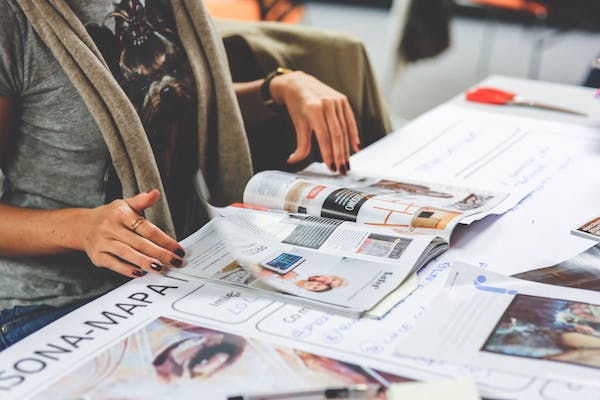
This article was originally published in Thrive Global, written by one of our Personal Stylists.
I’ll never forget my Psych 101 professor in university. Our class was at 8AM in the dead of winter, and while the room was filled with students in some variation of sweats and flannels, she arrived every day in what can only be categorized as ‘proper outfits’. She was a mix of J Crew catalogue meets Carrie Bradshaw accessories; always perfectly layered, and never a detail overlooked.
I was initially suspicious, chalking her extra effort up to the start of a new semester. But when most people would’ve reverted back to their old ways, typically around the 2 to 3-week mark, she never wavered.
It was apparent that she wasn’t forcing herself to put on a front. This look was a part of who she was; her personal uniform that she’d put careful attention into building. One that said, I’m sophisticated, cultured and professional, but also not too stuffy and have a panache for playfulness.
She stays in my mind all these years later for the certainty she so clearly felt within herself and the authority she commanded when she spoke. She knew who she was and found a way to use her image to say exactly what she wanted it to say. It was the first time I really understood the power we each have to create our personal narrative, just by strategically choosing how to dress.
The Clothing We Wear is More Important Than We May Realize
If you took a survey, most people wouldn’t really be able to tell you why they wear what they wear. More often than not, items and styles we consider favorable are usually just subconscious choices we’ve been making for as long as we can remember. We like them because they’re familiar and have become our go-to options, not necessarily because they portray an image we intentionally developed.
But whether we have an interest in fashion or not, the clothing we wear sends a very loud message about who we are, well before we ever open our mouths to speak. Not just to others, but also to ourselves, and it’s up to us to decide whether or not we’re going to control that narrative. Our personal style doesn’t define our ability or what we’re capable of, but it influences how we feel and how we’re perceived. Best of all, it’s something that’s completely within our control!
How to Develop Your Unique Personal Style:
#1 ACKNOWLEDGE WHAT HASN’T BEEN WORKING
In order to figure out what you want to achieve, it’s important to start with an honest assessment. Developing your personal style is all about generating confidence, so it’s critical to look at the relationship between the clothing you wear and how it impacts your state of being.
Reflect on times when you’ve felt disempowered. What were you wearing and did you struggle to put that outfit together? Look further to see if there are patterns in these experiences. When you give presentations, for example, are you consistently aware of your appearance and the way your coworkers see you? Does date night leave you struggling to find clothing that makes you feel like the best version of yourself?
Your wardrobe should act as a natural extension of who you are, showcasing your features and personality. Acknowledging when it’s not serving its purpose lets you know which areas to pay most attention to.
#2 DETERMINE HOW YOU WANT TO SHOW UP IN THE WORLD

Ask yourself how you’d like to be perceived by your clients, spouse, community, and anyone else you interact with. Establishing a description of how you want to show up in the world, provides the foundation for your unique personal style.
Choose words that paint a vivid mental picture of the way you want to be seen. These will become your ‘style descriptors’. Adjectives like powerful, compassionate, sophisticated and intelligent, provide a measurement to assess your image against.
It’s important to keep in mind that you’re always driving your personal narrative, whether you’re conscious of it or not. What do you want your style to say?
#3 IDENTIFY YOUR STYLE ICONS
Studying the work of those who’ve already mastered a skill is a useful place to start when learning something new. As you begin to determine the framework for your sense of style, it’s helpful to draw inspiration from people who fit your mold.
Whether it’s celebrities, politicians, TV characters, or co-workers, make a list of individuals you view as consistently well-dressed. Getting clear on who you look up to helps you better identify what your preferences are as you build a unique personal style of your own.
This exercise can often feel difficult. As creatures of habit, it’s challenging to envision ourselves wearing something other than what we’re familiar with. For the time being, ignore the natural hesitation to step outside your comfort zone and instead focus on what appeals to you.
#4 BUILD A VISUAL STYLE GUIDE

Create a collection of images that reflect your desired sense of style – search for outfits you’d like to try, icons who embody your aesthetic, and anything else you can use as reference to help build your personal brand.
Pinterest is a great platform for compiling ideas. Their algorithm is quick to learn your preferences and make personalized recommendations. Alternatively, you can save images into a designated folder on your phone, or cut out pictures from magazines and build a physical mood board.
Collecting photos allows you to see what your preferences look like as a whole and easily identify patterns in your taste. This visual framework serves as your style guide while you begin to put outfits together and decide what you’re going to wear.
#5 ASSESS WHAT YOU OWN & LET GO OF WHAT DOESN’T ALIGN
Getting clear on the image you’re creating for yourself will help you assess what’s in your closet with honesty and objectivity. Chances are you’ve been wearing the same thing for years, not because you chose it strategically but because it was familiar. It’s time to be more methodical about what you’re wearing.
Review your current wardrobe piece by piece, to determine if each item fits with the style you plan to achieve. Commit to letting go of anything that doesn’t align. Holding on to clothing out of sentimental attachment will only guarantee you repeat old patterns. Keep the items that match your goals and part with everything the rest.
A closet that serves you well doesn’t have to be one with endless options. Your ultimate goal is a capsule, comprehensive wardrobe where everything works together interchangeably and creates a style that’s uniquely you.
#6 EXPLORATION AND DISCOVERY
When you initially built your Pinterest board, you may have included photos of women like Meghan Markle and Chrissy Teigen. After all, they’re very fashionable! But as it turns out, your lifestyle is different than theirs and those red-carpet ensembles don’t exactly translate to your 9-to-5.
That’s ok, it’s all part of the process! Building your image doesn’t happen instantaneously, so give yourself permission to play around and explore. Creating a sense of style is a trial and error process designed to help you discover what makes you feel like the best version of yourself.
Use what’s in your closet to experiment with new outfit combinations. Go to the store and try on silhouettes you’ve never seen your body in. Borrow that floral dress from your girlfriend to test whether a boho-vibe may be more your speed.
When you step outside your comfort zone, you discover new possibilities for yourself and are able to create a look that’s authentically you.
#7 STRATEGIC SHOPPING

To shop effectively, you’ll need to have a plan in place otherwise you’re destined to repeat similar buying habits you’ve formed up to this point. Make a list of specific items you’re missing in your current wardrobe, so you’re clear on what you’re looking for when you get to the mall. That top you already have 3 of that just so happens to be on sale now, is not why you came. Stick to the plan!
It helps to break up your shopping, and focus on a few items each trip. Our minds have a tendency to get overloaded when we have too much to consider. If jeans and work pants are on your list, save blouses and sweaters for another day. You’re much more likely to find what you need when you’re not clouded by decision-fatigue.
Commit to buying only the clothing that make you feel like the best version of yourself. If you try something on and don’t immediately experience excitement, don’t buy it. If all the dresses feel just ‘ok’, and you have to convince yourself one is a winner, look elsewhere. Purchases like these almost never end up getting worn. Save your money for the styles you love, and don’t settle for something in between.
#8 GET EXCITED TO GET DRESSED
When you’re clear on your unique sense of personal style, and have built a wardrobe that reflects your message, getting dressed no longer feels overwhelming. It’s one step in your morning routine that sets you up to operate from a place of empowerment.
Wearing clothing that makes you feel good, ignites your self-confidence and drives you to perform at a higher level. When you feel your best, not only do you command more authority from others, but you have a greater trust within yourself. You take more risks, asset more attention, ask for what you want, and push yourself to be better.
Style is so much more than nice clothing and designer trends. It’s one of many tools at our disposal, we can use to help us show up in the world as the best version of ourselves.
Remember, it’s a work in progress and you’re always evolving. Have fun with the process, make it your own, and see what’s possible for you!
Photo Credit: Pexels, Uplash
![]()
CONNECT WITH US
Virtual Personal Styling Services – availble worldwide
